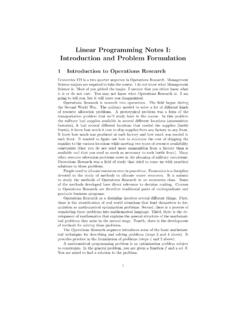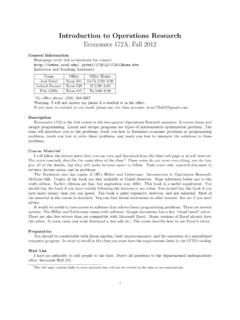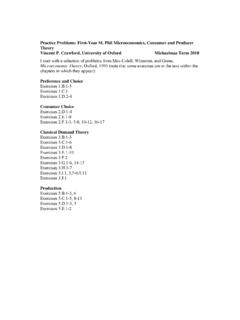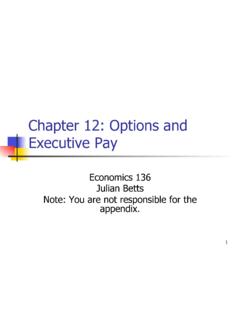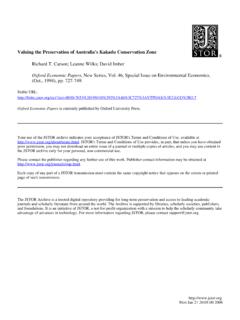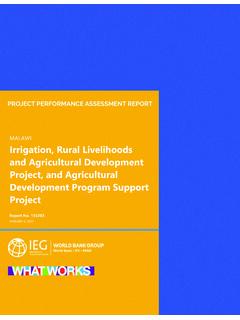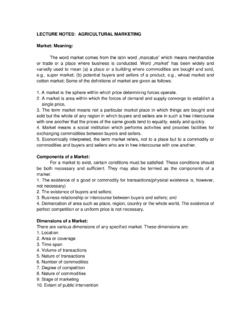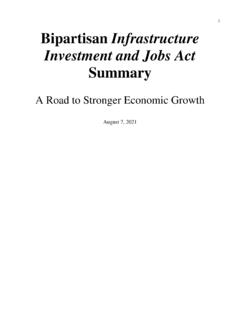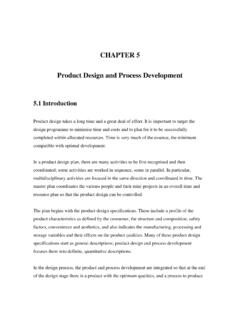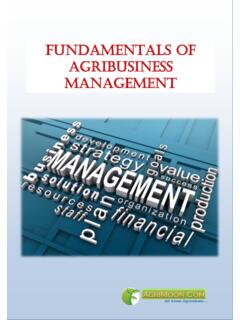Transcription of Leading Issues in Economic Development
1 Leading Issues in Economic Development SEVENTH EDITION. GERALD M. MEIER. Stanford University JAMES E. RAUCH. University of California, San Diego New York Oxford OXFORD UNIVERSITY PRESS. 2000. CONTENTS. LIST OF EXHIBITS xv PREFACE xvii USING THIS BOOK xix I. INTRODUCTION 1. Overview 1. MEASURING Development 5. Note The Evolution of Measures of Development 5. Selection Why Are Services Cheaper in the Poor Countries? 13. Comment The Productivity and Factor Proportions Explanations Again 17. Selection Burden of Poverty 18. Comment Capabilities and Entitlements 30. Economic PERFORMANCE OF LESS DEVELOPED COUNTRIES: THE RECENT PAST 35. Selection The East Asian Miracle 36. Selection East Asian Crisis: An Overview 42. Selection Completing China's Move to the Market 48.
2 Selection Latin American Economic Development : 1950 1980 52. Selection The Launching of the Reforms 58. Selection Indian Economic Reforms: Background, Rationale, Achievements, and Future Prospects 61. Note The Triumph of Laissez-Faire? 64. Selection Explaining Africa's Development Experiences 65. THE DISCIPLINE OF Development ECONOMICS 69. Note Evolution of Development Economics 69. Comment Classical Growth Theory 72. Comment Development Economics as a Special Subject 73. Note New Endogenous Growth Theory 75. vii viii CONTENTS. II. HISTORICAL PERSPECTIVE 77. Overview: The Division of the World 77. Selection The Spread of Economic Growth to the Third World: 1850 1980 80. Comment State-owned Enterprises and Privatization 96. Selection The Division of the World and the Factoral Terms of Trade 97.
3 Note Why Not Export First? 102. Note The Lewis Model of the World Economy 104. Selection agricultural Productivity, Comparative Advantage, and Economic Growth 107. Comment Income Elasticity of Demand for Food in the Matsuyama Model 110. Selection Income Distribution, Market Size, and Industrialization 111. Comment Minimum Market Size in the Murphy Shleifer Vishny Model 113. Selection Divergence, Big Time 114. III. SAVINGS AND investment 119. Overview: Savings The Engine of Growth? 119. Note The AK Model 123. Selection Is Fixed investment the Key to Economic Growth? 126. Selection Interest Rates in the Organized Money Markets of Underdeveloped Countries and Interest Rates Outside the Organized Money Markets of Underdeveloped Countries 129. Selection Financial Liberalization in Retrospect: Interest Rate Policies in LDCs 133.
4 Comment Financial Liberalization 136. Selection Financial Development and Economic Growth in Underdeveloped Countries 138. Selection Financial Development and Economic Growth: Views and Agenda 141. Selection Good Policy or Good Luck? Country Growth Performance and Temporary Shocks 147. Comment Policies Versus Shocks: A Closer Look 153. IV. INTERNATIONAL TRADE AND TECHNOLOGY TRANSFER 155. Overview 155. TRADE 159. Selection Natural Resource Abundance and Economic Growth 161. Note Import-substituting Industrialization and the Infant-Industry Argument 168. Selection Typology in Development Theory: Retrospective and Prospects 170. Selection An Exposition and Exploration of Krueger's Trade Model 175. Comment Moving Up the Ladder and Changes in Relative Costs of Factors of Production 178.
5 CONTENTS ix Selection The Process of Industrial Development and Alternative Development Strategies 180. Selection Exchange Control, Liberalization, and Economic Development 187. Selection Trade Policy Reform 191. Comment Stabilization-cum-Liberalization Programs 193. Selection Getting Interventions Right: How South Korea and Taiwan Grew Rich 195. Note Tradeability of Intermediate Goods, Linkages, and Bottlenecks 202. FOREIGN CONTACT AND TECHNOLOGY TRANSFER 204. Note Learning in International Production Networks 204. Selection Technology Gaps Between Industrial and Developing Countries: Are There Dividends for Latecomers? 206. Selection The Benefits of FDI 209. Note Trade as Enemy, Handmaiden, and Engine of Growth 211. V. HUMAN RESOURCES 213.
6 Overview 213. EDUCATION 216. Note Three Views of the Contribution of Education to Economic Growth 216. Selection The Role of Human Capital in Economic Development : Evidence from Aggregate Cross-Country Data. 218. Selection Economic Impact of Education 223. Comment Ability Differences, Spillovers, and the Returns to Education 226. Comment Education and Development 227. Selection Interpreting Recent Research on Schooling in Developing Countries 229. Selection Schooling Quality in a Cross Section of Countries 234. Selection Creating Human Capital 237. POPULATION 241. Note The Size of the World's Population and the Size of the Average Family 241. Selection Economic Approaches to Population Growth 242. HEALTH AND NUTRITION 249. Selection Health and Nutrition 254.
7 Selection Investing in Health 257. GENDER AND Development 263. Selection Women's Education in Developing Countries: An Overview 263. x CONTENTS. Selection Women in the Labor Force 271. Selection Women, Poverty, and Development in the Third World 275. Selection Women in Developing Countries 280. Selection Missing Women 283. Selection Grameen Bank: Performance and Sustainability 285. Comment The Grameen Bank and Empowerment of Women 287. Comment Gender-Aware Analysis 288. VI. MIGRATION AND THE URBAN INFORMAL SECTOR 289. Overview: The Evolving View of Urban Underemployment, the Informal Sector, and Their Connection with Rural-Urban Migration 289. Selection Urban Growth in Developing Countries: A Demographic Reappraisal 293. Selection Economic Development with Unlimited Supplies of Labor 297.
8 Selection A Model of Labor Migration and Urban Unemployment in Less Developed Countries 300. Note The Lewis Versus the Harris Todaro View of Underemployment in Less Developed Countries 302. Selection Wage Spillover and Unemployment in a Wage-gap Economy: The Jamaican Case 307. Note Econometric Studies of Migration 312. Selection The Informal Sector 313. Selection A Reassessment of Kenya's Rural and Urban Informal Sector 316. Selection Labour Market Modelling and the Urban Informal Sector: Theory and Evidence 318. Selection The Role of the Informal Sector in the Migration Process: A Test of Probabilistic Migration Models and Labour Market Segmentation for India 323. VII. AGRICULTURE 329. Overview 329. THE IMPORTANCE OF AGRICULTURE FOR Economic Development 332.
9 Selection Development Strategy in a Limping World Economy 332. Note Food, Hunger, Famine 335. DESIGNING AN agricultural STRATEGY 336. Selection Some Theoretical Aspects of agricultural Policies 336. Selection Criteria for the design of agricultural Development Strategies 340. Comment The Green Revolution 345. CONTENTS xi Comment Land Reform 346. Selection The agricultural Transformation 347. Note Induced Technical and Institutional Change 350. MICROECONOMICS OF THE RURAL SECTOR 352. Selection The New Development Economics 352. Selection Contractual Arrangements, Employment, and Wages in Rural Labor Markets: A Critical Review 356. Selection The New Institutional Economics and Development Theory 359. Selection Rural Credit Markets and Institutions in Developing Countries: Lessons for Policy Analysis from Practice and Modern Theory 361.
10 Selection A Survey of agricultural Household Models: Recent Findings and Policy Implications 364. Comment Supply Functions and Price Responsiveness 366. agricultural PRICING POLICY AND URBAN BIAS 368. Note agricultural Pricing Policy 368. Selection Urban Bias 370. Comment Rural Urban Terms of Trade 373. Comment Rural Urban Divide 373. VIII. INCOME DISTRIBUTION 375. Overview 375. Note Measurement of Income Inequality 379. THE IMPACT OF Development ON INCOME DISTRIBUTION 382. Selection Economic Growth and Income Inequality 382. Selection Inequality, Poverty, and Development 387. Selection Growth and Income Distribution 391. Selection A Note on the U Hypothesis Relating Income Inequality and Economic Development 394. Selection Economic Development , Urban Underemployment, and Income Inequality 395.
